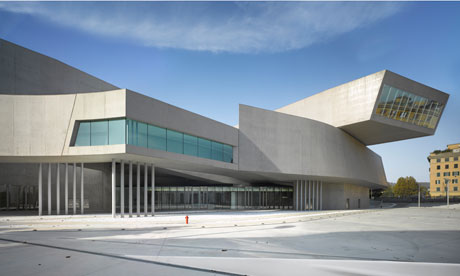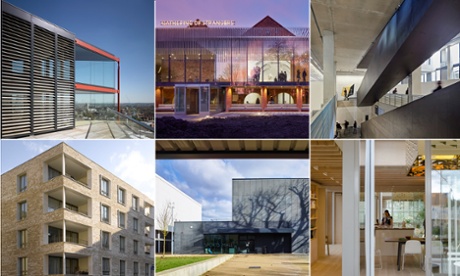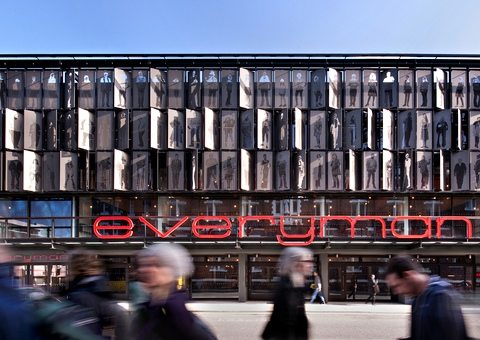What do the Eden Project, the British Library, the Neues Museum in Berlin, Birmingham Selfridges, Tate Modern and the Olympic velodrome have in common? They are all the exceptional buildings of their years – buildings that future historians will see as defining the era but that failed to win the Stirling prize, the award that is supposed to spot just such works. In most cases those that actually did take the prize will linger in the memory very much less.
For, useful as it is at drawing attention to contemporary architecture, the prize has a knack for recognising the good-but-not-great, the easier option, the thing chosen more for somewhat contingent reasons than architectural skill and imagination. It tends to arrive some years late at whatever new thinking might be animating the profession. It has the instinct, common to decisions made by committees, of favouring everyone’s second favourite.
Individual choices, of course, are the subject of legitimate debate. They were not bad decisions to honour the Everyman theatre in Liverpool in 2014, or the Sainsbury Laboratory in Cambridge in 2012, but on both occasions the prize jury passed up on braver, stronger, richer, more boundary-pushing, heart-stirring and no less proficient works, in the Hepworth gallery in Wakefield and the Saw Swee Hock student centre for the London School of Economics. This kind of preference constitutes, over time, a pattern.
This year the Royal Institute of British Architects’ awards system has excelled itself, in failing to give at least two outstanding works the regional awards that are necessary to get to the starting line for the Stirling. The polychrome, richly ornamented House for Essex by the architects FAT and the artist Grayson Perry is a tour de force of imagination, craft, detail and of three-dimensional creativity, which is surely the fundamental attribute of architecture, but it wasn’t enough to win one of 12 awards given by RIBA East. The Liverpool Philharmonic, a discreetly daring revival of a historic building by Caruso St John, couldn’t get past RIBA North-West.
I have no idea what muddled thinking, what misdirected good intentions, what pettiness, what insecurities go through the heads of the good people who made these choices, but they have done a disservice both to their regions and to architecture in the country as a whole. It is made worse by some of the works that did win regional awards, which are in the ho-hum, all right, marks-for-effort, B+, bit-better-than-average category. Particularly striking is the preference for Home in Manchester over the Liverpool Philharmonic, Home being a publicly funded arts centre that ends up looking like a ponced-up multiplex.
These omissions mean that the Stirling prize shortlist is, if not Hamlet without the Prince, Reservoir Dogs without Mr Pink and Mr Blonde. Perhaps the House for Essex would have been thought too esoteric ultimately to win (though what’s wrong with the esoteric?) and the Philharmonic too nuanced (and ditto nuance?), but they would at least have been good subjects for debate. Some of those included are interesting, some less so. There is no outstandingly obvious winner.
The probable frontrunner is Herzog and De Meuron’s Blavatnik School of Government in Oxford, whose splendiferous interior is funded by many millions from the eponymous billionaire’s aluminium-based fortune. It is one of the greatest spaces in the not-too-shabby history of the university’s architecture, which could well be enough to win it the prize. The exterior is more problematic, hermetic and excluding, a too-honest representation of the them-and-us culture in which the future world leaders – for now students at the Blavatnik – will probably operate.
Trafalgar Place in Elephant and Castle, London, by dRMM and the developers Lend Lease, is one of the new-ish wave of thoughtful housing schemes, which work within tough constraints to achieve such things as a pleasant central garden for the residents. Unfortunately it’s part of the redevelopment of the 1970s Heygate estate, whose erasure entailed disruption of tenants’ lives, the loss of hundreds of council flats and indeed of a pleasant central garden. Although these losses are not the architects’ fault, it’s wrong that the opportunity wasn’t taken to recognise councils such as the London boroughs of Brent, Camden or Hackney, who are more committed to good housing than Lend Lease and manage not to incur such devastating side effects.
I haven’t visited the Riverside Campus of the City of Glasgow College, but images, plans and reports suggest that it is a dignified and well-planned home for an institution whose aim is to revive the industrial skills of a city once famous for them. Its designers, Michael Laird Architects and Reiach and Hall Architects, have made it one of very few projects that connect Glasgow well to the Clyde. My main informant, Owen Hatherley in the Architects’ Journal, questions its possibly cliched use of a large central atrium and the quality of details achieved by its contractor. Even so, it should be a contender.
I also haven’t seen the Outhouse in the Forest of Dean by Loyn and Co, but unless there are some spatial miracles to be discovered at first hand I can’t for the life of me see why it is on the list. This is not to denigrate the taste and courage of the artistic couple who commissioned a striking modern house in a rural area, but it’s hard to see much in the architectural concept that wasn’t better done in Mies van der Rohe’s Tugendhat house, in Brno, Czechoslovakia, in 1930. The newer house is more sustainable, for sure, but its details tend towards the clumsy and unimaginative.
The Weston Library in Oxford is by Wilkinson Eyre, winners of the Stirling prize in both 2001 and 2002. A previous architecture critic for the Observer compared their version of modernism to the products of Pizza Express – decent but predictable – and if this was harsh the elapse of 15-odd years has not made their work more cutting-edge. The Weston is a competent and professionally committed reworking of a historic building, albeit with some awkwardness in its spatial arrangements, but without the spark that you would hope for in a Stirling prize winner.
This leaves the Newport Street Gallery in London, created by Damien Hirst to display to the public his remarkable collection of artists other than himself. This is by the same Caruso St John who were slighted in Liverpool, and it has some of the same qualities as their Philharmonic. It is the editing and renewal of existing buildings – in this case former workshops for building theatre sets – with a combination of tact and boldness. Sometimes you can hardly tell the new from the old. Sometimes, as with some staircases of real beauty, you can’t miss it. The whole is a wonderfully judged balance of architecture and art. It may be the creation of a multimillionaire artist with his own agenda to pursue, but it has a real and generous public spirit.
Alongside the Stirling’s tendency to pick the second-best goes a habit of slowness in recognising the most significant architects. They did this with David Chipperfield, Zaha Hadid and Will Alsop. Caruso St John have done particularly badly – they should have won in 2000 with their breakthrough project, the New Art Gallery in Walsall, and later their exceptional Nottingham Contemporary didn’t make the shortlist. This year the Stirling’s jury has the chance to put right those wrongs and choose what is, in the end, the best work of architecture in front of them.
The winner of the 2106 Stirling prize will be announced on 6 October











